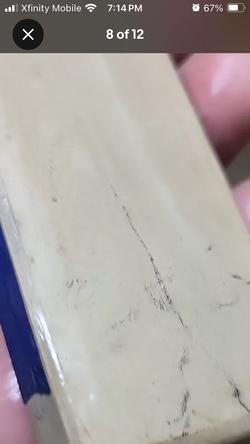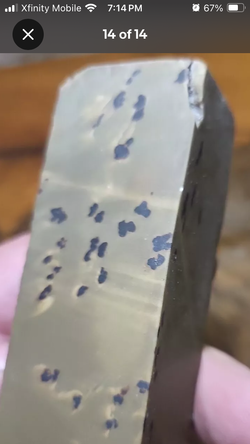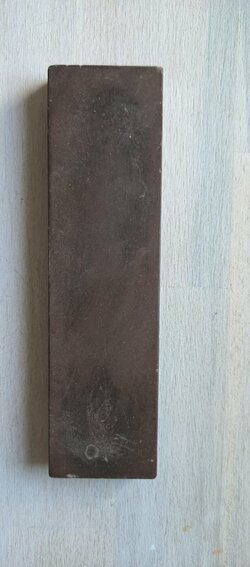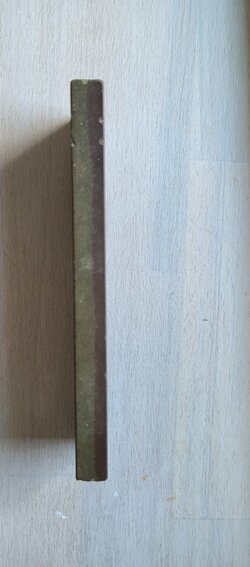I believe Marples was labeling CF stones by at least 1860 and possibly as early as the 1830's. They didn't have them on the menu after around 1900 either.The other thing of course is that branding and labelling of whetstones is a relatively recent thing. If anyone can show me a stone label that definitely predates when Pike and WoAToS started doing it at the tail end of the c.19th, then I'd love to see it.
The quarrying of slate as a building material (and hence as a whetstone material) was a far more important industry in the middle of the c.19th century than it was by the middle of the c.20th. And the timeline of that decline also happens mirror the replacement of natural sharpening stones following the synthesis of man-made SiC and Al2O3, also at the end of the c.19th.
A lot of slate whetstones are just old, and came from a time when nobody labelled whetstones. And because slate was a very important building material, and it all looks the same... there are a lot of 'mystery slate' hones out there.
You are using an out of date browser. It may not display this or other websites correctly.
You should upgrade or use an alternative browser.
You should upgrade or use an alternative browser.
Mystery hones... Let's see what you have
- Thread starter kcb5150
- Start date
I believe Marples was labeling CF stones by at least 1860 and possibly as early as the 1830's. They didn't have them on the menu after around 1900 either.
I’m not so sure about that T. WM Marples didn’t even exist as such until 1860…
Last edited:
Is it one of those old black la lunes? From the first picture that was my first thought. They had some variation. Some were dense smooth slate and the vintage one I have now(that I've still not flattened) has little pores in it.This one kind of has the dimensions of the dense, fat slates with the wide chamfers and wooden boxes you can sometimes find in spain/portugal but it doesn't really feel like those to be honest.
You seem to be on Roger’s page, but yes you are correct if you are speaking of William Marples and Sons, but Marples was selling out of Hibernian works since 1837 and WM. Marples & Sons was used since at least 1860 and it was Hibernia works by then. By 1875 they used the triple shamrock with the Hibernia and the label on that stone has no shamrock. Although the triple shamrock was a registered trademark since 1862.I’m not so sure about that T. WM Marples didn’t even exist as such until 1860…
View attachment 1842002
1830 William Jnr. started his own business in Broomhall St.[Legally when he was 21 yrs old. not in 1828 as you will find reported elsewhere and as shown in the MARPLES catalogues. This date was to try to convince the public that William Marples‘ firm was in existence before his cousin’s {Robert Marples] firm. A great competition in those days.
1833 Whites directory lists ‘Marples Wm. jun joiners’ tool, brace bit and skate manfr. Broomhall Street’.
1837 Moved to larger premises at 67/69 Broomspring Lane (aka Broom Spring Lane or Spring Lane) “Hibernian Works” Probablyit was 1837 because ‘Whites’ stills lists Broomhall St. in 1833.
1846 The first William Marples Jun. catalogue may have been issued. [just a Broadsheet]
He has the 1846 catalogue. 1861 was the first hard backed catalog.
- Thread starter
- #2,325
No not any lune
This sweet thing showed up with an old boat Coti I picked up from the UK. Nice surprise.


This sweet thing showed up with an old boat Coti I picked up from the UK. Nice surprise.
View attachment 1842329View attachment 1842331
Ya lucky dog, nice!!
This sweet thing showed up with an old boat Coti I picked up from the UK. Nice surprise.
Moughton, right? Nice one, I don't have that one yet.
Not many people do.Moughton, right? Nice one, I don't have that one yet.
This sweet thing showed up with an old boat Coti I picked up from the UK. Nice surprise.
View attachment 1842329View attachment 1842331
Sweet.
(That guy is a feckin gent!)
Moughton stone?This sweet thing showed up with an old boat Coti I picked up from the UK. Nice surprise.
View attachment 1842329View attachment 1842331
@Empire straights
Yes it’s a Moughton
Yes it’s a Moughton
What color is the slurry?
any ideas of what this is, would it be good for chisels and planes as a finishing stone
Beautiful thread ..! I have yet to acquire my first "mystery rock", but this thread is an encouragement to get one ...
Sold as “Mystery Stone”. Felt this was the appropriate place to post these stones I know nothing about. These are the sellers pics. I was planning on getting a shapton pro 1.5k but my itchy trigger finger hit the button (twice) before I could stop it.
Attachments
Troutstone, I think? Spotty one could be a weird Charnley. Def novaculite.Sold as “Mystery Stone”. Felt this was the appropriate place to post these stones I know nothing about. These are the sellers pics. I was planning on getting a shapton pro 1.5k but my itchy trigger finger hit the button (twice) before I could stop it.
I hope someone on here snagged that mystery stone in the 1792 paddle. I completely missed my alarm to bid on it. Went for a great price.
Those unlabeled combination stones are usually ceramic silicon carbide, coarse (often very coarse!) on one side a fine on the other. They vary quite a bit, and some are aluminum oxide. Usually the fine side is too coarse for razors, but they make decent knife stones for rough work, and can be use for carpentry tools. Not usually fine enough for cabinet making though.
Occasionally you will find one that burnishes on the fine side, and those make good bevel setters for razors.
Nothing wrong with silicon carbide (Carborundum is the trade name) as an abrasive, but those old combo stones tend to be rather coarse.
Occasionally you will find one that burnishes on the fine side, and those make good bevel setters for razors.
Nothing wrong with silicon carbide (Carborundum is the trade name) as an abrasive, but those old combo stones tend to be rather coarse.
Similar threads
- Replies
- 54
- Views
- 5K
- Replies
- 103
- Views
- 10K
- Replies
- 19
- Views
- 2K







